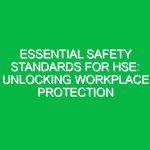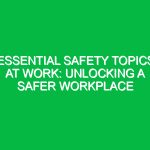Introduction
Good morning, team! Today, we’re having an important toolbox talk about a topic that affects each and every one of us: New Employees on the Job. As we welcome new faces into our workplace, it is vital to ensure they understand our Health, Safety, and Environment (HSE) practices. This discussion will not only help integrate them smoothly but also enhance our overall Safety culture. A well-informed team is a safe team.
The Importance of HSE for New Employees
When new employees join our organization, they bring fresh perspectives and skills. However, they may also be unfamiliar with our specific operational Procedures and Safety protocols. Understanding the New Employees on the Job context is crucial to prevent accidents and ensure compliance with safety Regulations. It’s our responsibility to guide them effectively.
Key Components of HSE for New Employees
Let’s break down the essential components of HSE that new employees must grasp:
- Understanding Risks: New employees need to be aware of the potential Hazards in their work environment. This includes recognizing equipment-related risks, chemical exposure, and ergonomic issues.
- Compliance with Standards: Familiarity with safety regulations, company policies, and industry standards is crucial. This compliance is not merely about following rules; it’s about fostering a culture of safety that protects everyone.
- Emergency Procedures: New hires must know how to respond in emergencies, including evacuation routes, first-aid stations, and emergency contacts.
- Reporting Incidents: Knowing how and when to report accidents or unsafe conditions is vital. A proactive approach can prevent minor issues from escalating into serious problems.
Potential Hazards and Risks for New Employees
As we discuss New Employees on the Job, let’s consider some potential hazards that they may face:
- Inexperience: New employees may lack the familiarity required to navigate complex tasks safely. This inexperience can lead to accidents if they are not properly trained.
- Misunderstanding Safety Equipment: Proper use of Personal Protective Equipment (PPE) is crucial. New hires may not know how to use it correctly, increasing their risk of injury.
- Unfamiliar Work Environment: Every workplace has its unique risks. New employees may not recognize hazards that seasoned workers are aware of.
Best Practices for Integrating New Employees
To help new employees acclimate safely, follow these Best Practices:
- Comprehensive Orientation: Conduct a thorough orientation that covers HSE policies. This should include hands-on Training with equipment and safety procedures.
- Mentorship Programs: Pair new employees with experienced team members. This mentorship can provide guidance and support as they learn the ropes.
- Regular Check-Ins: Schedule regular meetings with new hires to discuss their experiences and address any concerns they may have about safety or their work environment.
- Safety Meetings: Encourage new employees to attend safety meetings and engage in discussions about HSE practices. Their fresh perspectives can be invaluable.
Real-Life Examples and Scenarios
To illustrate the importance of these practices, let’s consider a few hypothetical scenarios:
- Scenario 1: A new employee working on a construction site is not familiar with the equipment. During a routine task, they misjudge the distance of a moving vehicle, leading to a near-miss incident. If they had received proper training, this situation could have been avoided.
- Scenario 2: A new staff member in a laboratory setting is unsure how to handle hazardous materials. Without adequate training, they inadvertently expose themselves to harmful chemicals. Regular training and clear guidelines could prevent such risks.
Actionable Advice for New Employees
Here are some actionable tips for new employees to help them stay safe on the job:
- Ask Questions: Never hesitate to ask questions if you’re uncertain about a task or safety procedure. It’s better to seek clarification than to make assumptions.
- Observe and Learn: Watch how experienced colleagues handle tasks, especially those involving machinery or hazardous materials. Observational learning can be incredibly effective.
- Stay Alert: Always be aware of your surroundings. Look out for potential hazards and stay focused on your tasks.
- Participate Actively: Get involved in safety meetings and discussions. Your input can contribute to a safer work environment.
Regulations and Standards Related to New Employees
Compliance with safety regulations is not just a legal obligation; it’s essential for fostering a safe workplace. Here are some key regulations that apply:
- Occupational Safety and Health Administration (OSHA): osha sets and enforces standards to ensure safe working conditions. New employees must understand their rights and responsibilities under OSHA regulations.
- Company Safety Policies: Each company has its specific safety policies tailored to its operations. Familiarize yourself with these policies and understand their implications.
- Training Requirements: Various industries have mandated training programs for new employees. Ensure you complete these before starting your tasks.
Conclusion
In closing, integrating New Employees on the Job into our HSE culture is essential for everyone’s safety and productivity. By providing comprehensive training, fostering open communication, and encouraging active participation, we can create a workplace that not only complies with regulations but also prioritizes the well-being of all employees.
Thank you for your attention, and let’s continue to support each other in maintaining a safe and healthy work environment. Remember, safety is a shared responsibility, and together, we can make a difference!


